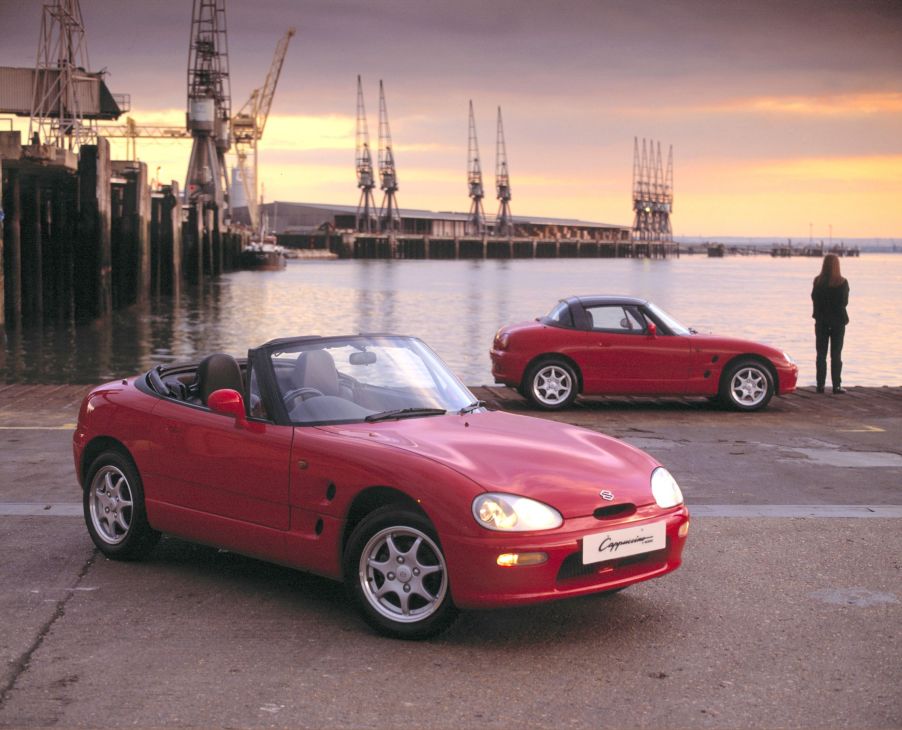
Mazda Miata Too Big? Take a Shot at the Suzuki Cappuccino
Practically every list of affordable sports cars mentions the Mazda Miata, and for good reason. But new or used, it’s not the only convertible sports car out there. It’s not even the only Japanese option—it’s just that some never made it overseas. Thanks to the 25-year rule, though, these JDM rear-wheel-drive roadsters can now make it onto US roads. That means driving enthusiasts can finally get a taste of the Suzuki Cappuccino.
A Suzuki Cappuccino is like a smaller-scale turbocharged Mazda Miata

On a basic level, the 1991-1997 Suzuki Cappuccino shares a few things with the Mazda Miata. Both are front-engine, RWD convertible sports cars with relatively modest power. However, park them next to each other and their differences become clear. And the biggest one is that the Cappuccino is scaled “like a Mazda Miata that was left in the dryer,” Hagerty points out.
That size difference is because the Suzuki Cappuccino is a kei car. In Japan, space is at a premium. And after WWII, the country needed cheap and frugal ways of getting around. These needs spawned the ‘kei car’ vehicle class, which is still around today. Government regulations mean these cars are tiny and pack motorcycle-sized engines. But the owners benefit from inexpensive transportation that’s cheap to insure and run, not to mention easier to park.
And kei sports cars like the Suzuki Cappuccino enjoy a few more benefits. Although it’s less than 11’ long and 5’ wide, it’s also light. Depending on the trim, the Cappuccino “barely” weighs 1540 lbs, AutoExpress reports. True, it’s not as fast in a straight line as even an NA Mazda MX-5 Miata. But its 657cc three-cylinder engine is turbocharged, so it makes 64 hp and 76 lb-ft of torque in 1995-and-later, Driving.ca says. And with a bit of tuning, you can get 90 hp at the rear wheels, Road & Track reports.
Plus, like the NA Mazda Miata, the Suzuki Cappuccino has a five-speed manual and fully independent suspension. Some trims even offered limited-slip differentials. All Cappuccinos, though, have 50:50 weight distribution, Hagerty notes. So, like the Miata, they’re also a hoot to drive.
The most practical ‘ABC’ RWD kei sports car doesn’t skimp on fun, Hagerty says
Given that kei cars were originally designed for fairly utilitarian reasons, the idea of a kei sports car might seem odd. But it’s worth remembering that the Suzuki Cappuccino dates back to the ‘bubble economy’ era. Flush with cash, Japanese automakers could indulge in ‘less practical’ projects. Say, a convertible, RWD kei car.
The Cappuccino wasn’t the only kei sports car available at the time, though. There was also the mid-engine Honda Beat, another convertible. And those who wanted the supercar experience in a tiny package could get the Autozam AZ-1. If you hear someone talk about an ‘ABC kei car,’ they’re referring to these three.
While the Suzuki Cappuccino doesn’t have the AZ-1’s gullwing doors or the Beat’s mid-engine layout, it does have more torque. Combined with a lower curb weight and a wider power band, that makes it faster than the Beat, Hagerty says. It also has a larger trunk than either of the other two ABC cars, making it arguably the most practical. Plus, the Cappuccino’s roof is configurable—you can take it off or turn it into a T-top or Targa roof. And you can store it in the trunk, just like in the C8 Corvette.
But you don’t buy a kei sports car for practicality—you buy it for the experience. And the Suzuki Cappuccino delivers on that promise. The suspension and tires offer a surprising amount of grip, while the steering is “sharp and precise,” AutoExpress reports. Being narrow, the Cappuccino is easy to position within a lane or a corner. And its low ride height amplifies the sense of speed. If you love how the Mazda Miata handles, you’ll enjoy this Suzuki, too.
How much is a Suzuki Cappuccino worth?

All but the very last Suzuki Cappuccinos are eligible to import. And unlike the AZ-1 and the Beat, a few Cappuccinos were sold outside of Japan—specifically, in the UK. The downside is that UK-market ones offer fewer color options, AutoExpress notes.
Whether UK- or Japan-market, Cappuccinos tend to be fairly affordable. Most examples from importers like Toprank Importers and Duncan Imports go for $10,000-$12,000. But Cappuccinos on auction sites like Bring a Trailer and Cars & Bids often go for $6000-$10,000. And as long as they’ve been properly maintained, they’re reliable cars. However, if you plan on modifying the engine, Hagerty recommends going with the 1991-1994 models. Their ‘F6A’ engines only make 63 lb-ft of torque, but they can stand up to more mods.
Regardless, if you want Mazda Miata fun concentrated into a smaller, more unusual package, the Suzuki Cappuccino might be worth a shot.
Follow more updates from MotorBiscuit on our Facebook page.


